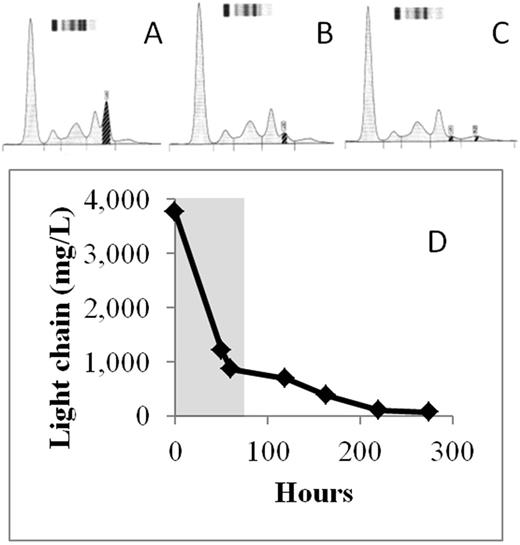Abstract
Myeloma cast nephropathy or myeloma kidney (MK) is a complication observed in up to one third of patients with multiple myeloma (MM). MM patients who recover kidney function have longer remissions and increased overall survival. Previous attempts at light chain reduction with the use of plasma exchange in addition to chemotherapy have not consistently improved patient outcomes and remains an area of research. The inefficiency of plasma exchange is due to the high volume of distribution of light chains in the extravascular space which will repopulate the vascular space once the exchange procedure is complete.
Continuous Veno-Venous Hemofiltration (CVVH) is a form of continuous hemodialysis (HD). The use of CVVH in addition to chemotherapy in MK is rational, as continuous filtration allows for ongoing equilibrium between the extravascular and intravascular compartments, thus reducing the total body MM protein load. The Purema 500 (NxStage Medical, Lawrence, MA) filter used for CVVH has an average pore size of 65 kDa, and albumin Sieving co-efficient of 0.05. The myeloma kappa light chain is approximately 25 kDa whereas the lambda light chain (LLC), circulating as a dimer, is approximately 45 kDa and the average IgG complex is approximately 150 kDa. These data suggest that CVVH filtration could reduce the light chain MM protein in patients with MK, but would likely be ineffective for IgG, IgA or IgM MM.
This hypothesis was tested in a 60 year-old-man with known normal baseline kidney function and LLC MM, who developed MK in the perioperative period, of a hip stabilization procedure, at the time of MM recurrence. Biopsy showed the kidney failure was due to MK. The LLC concentration at the time of kidney failure was 3,750 mg/L. We employed CVVH, run 24 hours a day for 72 hours, with concurrent high dose intravenous dexamethasone 40mg days 1-4 and IV bortezomib 1.3mg/m2 days 1,4,8, 11.
Serum protein electrophoresis (SPEP) obtained prior to CVVH showed a monoclonal spike of 6.7 g/L or 11.5% of the total protein (figure 1A). Protein electrophoresis (PEP) of the first bag of spent dialysate showed a restricted peak 1.1g/L or 2.1% of the total protein with a similar appearance to the monoclonal spike on the SPEP, demonstrating removal of the LLC by CVVH (figure 1B). 72 hours after the initiation of CVVH and chemotherapy, the LLC concentration decreased 77% from 3,750 to 850 mg/L (figure 1D), SPEP showed the monoclonal spike had decreased to 0.5 g/L or 1% of the total protein (figure 1C). The patient became dialysis independent three months following CVVH.
Previous series have reported on 11 patients with acute MK, who have been treated with as specialized high cut-off hemodialysis (HCO-HD) filter, which has a pore size of 45 kDa, and concurrent chemotherapy. Seven of these patients (63%) became dialysis independent. These studies showed an overall reduction of serum light chain protein in their patients, but did not report if the light chains were present in the dialysate. The EUropean trial of free LIght chain removal by exTEnded haemodialysis in cast nephropathy (EuLITE) reported an improved rate of renal recovery 33% vs 43% with the use of HCO-HD versus standard HD.
By way of comparison, CVVH, which is widely available in the United States, rapidly decreased the LLC myeloma protein. Our data supports the depletion of the LLC stores in the extravascular compartment as we did not see a rebound of LLC after stopping CVVH (figure 1D). As kappa light chains have a lower molecular weight than LLC, we would expect the same result with kappa light chain MM. Patients with IgG MK may also benefit from CVVH, as we saw proteins with a molecular weight higher than 65 kDa in the spent dialysate PEP, including proteins in the IgG range (figure 1C). CVVH filters lead to less protein wasting as compared to the HCO-HD filters which would negate the need for albumin replacement. The observed rapid rate of decline of the light chain concentration in this case supports the addition of CVVH to chemotherapy, as the clearance of the myeloma protein was more rapid than has been described in previous trials using bortezomib and dexamethasone alone. Randomized clinical trials would need to be conducted to know if this approach is superior to chemotherapy alone.
No relevant conflicts of interest to declare.
Author notes
Asterisk with author names denotes non-ASH members.


This feature is available to Subscribers Only
Sign In or Create an Account Close Modal